From its entry on Wikipedia for Fred Astaire and Ginger Rogers movies,
Fred Astaire (May 10, 1899 – June 22, 1987) and Ginger Rogers (July 16, 1911 – April 25, 1995) were iconic dance partners in a total of 10 films, nine of them with RKO Radio Pictures from 1933 to 1939, and one, The Barkleys of Broadway, with MGM in 1949, their only color film.
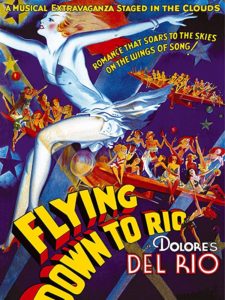
Flying Down to Rio – is a 1933 American pre-Code RKO musical film noted for being the first screen pairing of Fred Astaire and Ginger Rogers, although Dolores del Río and Gene Raymond received top billing and the leading roles. Among the featured players are Franklin Pangborn and Eric Blore. The songs in the film were written by Vincent Youmans (music), Gus Kahn and Edward Eliscu (lyrics), with musical direction and additional music by Max Steiner. This is the only film in which Rogers was billed above famed Broadway dancer Astaire.
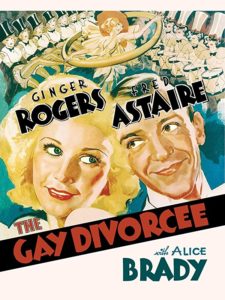
The Gay Divorcee – is a 1934 American musical film directed by Mark Sandrich and starring Fred Astaire and Ginger Rogers. It also features Alice Brady, Edward Everett Horton, Eric Blore, and Erik Rhodes, and was based on the Broadway musical Gay Divorce, written by Dwight Taylor from an unproduced play by J. Hartley Manners, which was adapted into a musical by Kenneth S. Webb and Samuel Hoffenstein
Mimi Glossop (Ginger Rogers) seeks a divorce from her geologist husband Cyril Glossop (William Austin), whom she has not seen for some time. Under the guidance of her domineering and much-married Aunt Hortense (Alice Brady), she consults incompetent and bumbling lawyer Egbert Fitzgerald (Edward Everett Horton), once a fiancé of her aunt. He arranges for her to spend a night at a seaside hotel and to be caught in an adulterous relationship, for which purpose he hires a professional co-respondent, Rodolfo Tonetti (Erik Rhodes). But Egbert forgets to arrange for private detectives to “catch” the couple.
By coincidence, Guy Holden (Fred Astaire) an American dancer and friend of Egbert’s, who briefly met Mimi on his arrival in England, and who is now besotted with her, also arrives at the hotel, only to be mistaken by Mimi for the co-respondent she has been waiting for. While they are in Mimi’s bedroom, Tonetti arrives, revealing the truth, and holds them “prisoner” to suit the plan. They contrive to escape and dance the night away.
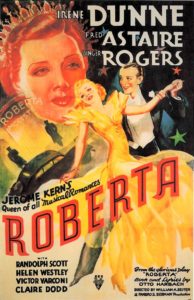
Roberta – is a 1935 American musical film by RKO starring Irene Dunne, Fred Astaire, Ginger Rogers, and Randolph Scott. It was an adaptation of a 1933 Broadway musical Roberta, which in turn was based on the novel Gowns by Roberta by Alice Duer Miller. It was a solid hit, showing a net profit of more than three-quarters of a million dollars.
John Kent (Randolph Scott), a former star football player at Harvard, goes to Paris with his friend Huck Haines (Fred Astaire) and the latter’s dance band, the Wabash Indianians. Alexander Voyda (Luis Alberni) has booked the band, but refuses to let them play when he finds the musicians are not the Indians he expected, but merely from Indiana (Huck Haines and his Indianians Band).
John turns to the only person he knows in Paris for help, his Aunt Minnie (Helen Westley), who owns the fashionable “Roberta” gown shop. While there, he meets her chief assistant (and secretly the head designer), Stephanie (Irene Dunne). John is quickly smitten with her.
Meanwhile, Huck unexpectedly stumbles upon someone he knows very well. “Countess Scharwenka”, a temperamental customer at Roberta’s, turns out to be his hometown sweetheart Lizzie Gatz (Ginger Rogers). She gets Huck’s band an engagement at the nightclub where she is a featured entertainer, and Huck agrees to keep her true identity a secret.
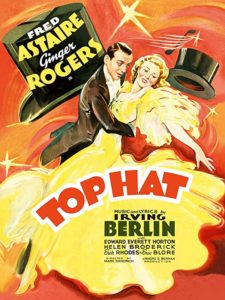
Top Hat – is a 1935 American screwball musical comedy film in which Fred Astaire plays an American dancer named Jerry Travers, who comes to London to star in a show produced by Horace Hardwick (Edward Everett Horton). He meets and attempts to impress Dale Tremont (Ginger Rogers) to win her affection. The film also features Eric Blore as Hardwick’s valet Bates, Erik Rhodes as Alberto Beddini, a fashion designer and rival for Dale’s affections, and Helen Broderick as Hardwick’s long-suffering wife Madge.
While practicing a tap dance routine in his hotel bedroom, Jerry Travers (Astaire) awakens Dale Tremont (Ginger Rogers) on the floor below. She storms upstairs to complain, whereupon Jerry falls hopelessly in love with her and proceeds to pursue her all over London.
However, in typical British farce fashion, Dale mistakes Jerry for Horace, who is married to her friend Madge (Helen Broderick). Following the success of Jerry’s opening night in London, Jerry follows Dale to Venice, where she is visiting Madge and modelling/promoting the gowns created by Alberto Beddini (Erik Rhodes), a dandified Italian fashion designer with a penchant for malapropisms.
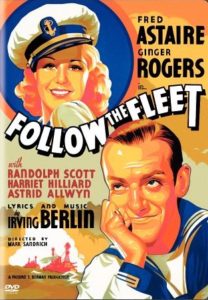
Follow the Fleet – is a 1936 American RKO musical comedy film with a nautical theme starring Fred Astaire and Ginger Rogers in their fifth collaboration as dance partners. It also features Randolph Scott, Harriet Hilliard, and Astrid Allwyn, with music and lyrics by Irving Berlin. Lucille Ball and Betty Grable also appear, in supporting roles. The film was directed by Mark Sandrich with script by Allan Scott and Dwight Taylor based on the 1922 play Shore Leave by Hubert Osborne.
Follow the Fleet was extremely successful at the box office, and during 1936, Astaire’s recorded versions of “Let Yourself Go“, “I’m Putting all My Eggs in One Basket“, and “Let’s Face the Music and Dance” reached their highest positions of 3rd, 2nd, 3rd respectively in the US Hit Parade.
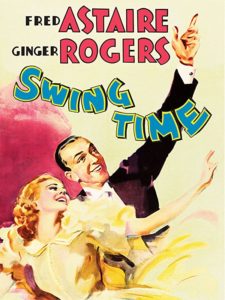
Swing Time – is a 1936 American RKO musical comedy film set mainly in New York City, and starring Fred Astaire and Ginger Rogers. It features Helen Broderick, Victor Moore, Betty Furness, Eric Blore and Georges Metaxa, with music by Jerome Kern and lyrics by Dorothy Fields. The film was directed by George Stevens.
John “Lucky” Garnett (Fred Astaire) is a gambler and dancer. He is set to marry Margaret (Betty Furness), but his friends hold him up quibbling about a minor alteration to his suit, so that he is late for the wedding. Margaret’s father phones to call off the wedding, but Lucky doesn’t get that message. His friends bet him that he will not be getting married, and he agrees to the bet. Margaret’s father tells Lucky that he must earn $25,000 to demonstrate his good intentions.
He and his friend “Pop” Cardetti (Victor Moore) try to buy train tickets, but his friends take his money – because he lost the bet. So they hitch the first freight train to New York. Broke, they wander around the city. Lucky meets Penny (Ginger Rogers), a dance school instructor, when he asks for change for a quarter. It’s his lucky quarter and Pop feels bad that Lucky lost it. They attempt to get it back, but Penny is in no mood to deal with them. When she drops her things, Pop sneaks the quarter out of her purse, and she thinks Lucky did it.
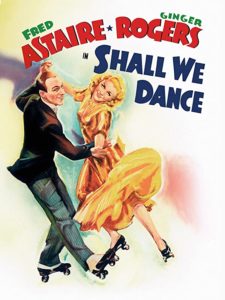
Shall We Dance – released in 1937, is the seventh of the ten Astaire-Rogers musical comedy films. The idea for the film originated in the studio’s desire to exploit the successful formula created by Richard Rodgers and Lorenz Hart with their 1936 Broadway hit On Your Toes. The musical featured an American dancer getting involved with a touring Russian ballet company. In a major coup for RKO, Pandro Berman managed to attract the Gershwins – George Gershwin who wrote the symphonic underscore and Ira Gershwin the lyrics – to score this, their second Hollywood musical after Delicious in 1931.
Peter P. Peters (Fred Astaire), an American ballet dancer billed as “Petrov”, dances for a ballet company in Paris owned by the bumbling Jeffrey Baird (Edward Everett Horton). Peters secretly wants to blend classical ballet with modern jazz dancing, and when he sees a photo of famous tap dancer Linda Keene (Ginger Rogers), he falls in love with her. He contrives to meet her, but she is less than impressed. They meet again on an ocean liner traveling back to New York, and Linda warms to Petrov. Unknown to them, a plot is launched as a publicity stunt “proving” that they are actually married. Outraged, Linda becomes engaged to the bumbling Jim Montgomery (William Brisbane), much to the chagrin of both Peters and Arthur Miller (Jerome Cowan), her manager, who secretly launches more fake publicity.
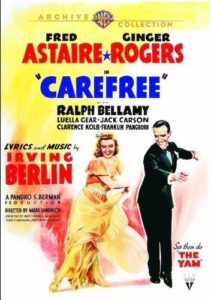
Carefree – is a 1938 musical film starring Fred Astaire and Ginger Rogers. With a plot similar to screwball comedies of the period, Carefree is the shortest of the Astaire-Rogers films, featuring only four musical numbers. Carefree is often remembered as the film in which Astaire and Rogers shared a long on-screen kiss at the conclusion of their dance to “I Used to Be Color Blind,” all previous kisses having been either quick pecks or simply implied.
Carefree was a reunion for the team of Astaire and Rogers after a brief hiatus following Shall We Dance and six other previous RKO pictures. The next film in the series, The Story of Vernon and Irene Castle (1939), would be their final RKO film together, although they would reunite in 1949 for MGM‘s The Barkleys of Broadway.
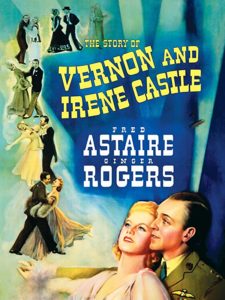
The Story of Vernon and Irene Castle – is a 1939 American biographical musical comedy directed by H.C. Potter. The film stars Fred Astaire, Ginger Rogers, Edna May Oliver, and Walter Brennan. The film is based on the stories My Husband and My Memories of Vernon Castle, by Irene Castle. The movie was adapted by Oscar Hammerstein II, Dorothy Yost and Richard Sherman. It was Astaire and Rogers’ last film together with RKO.
The film tells of novice American dancer Irene Foote (Ginger Rogers) who convinces New York-based British vaudeville comic Vernon Castle (Fred Astaire) to give up slapstick comedy in favor of sophisticated ballroom dancing.
Their big break comes when they are stranded in Paris, along with their friend Walter Ashe (Walter Brennan), with no money. They catch the eye of influential agent Maggie Sutton (Edna May Oliver), who arranges a tryout for them at the prestigious Café de Paris, where they become an overnight sensation. After taking Europe by storm, the Castles return to the United States and become just as big a sensation. Their fame and fortune rises to unprecedented heights in the immediate pre-World War I years.
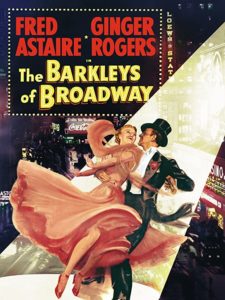
The Barkleys of Broadway – is a 1949 Technicolor musical film from the Arthur Freed unit at Metro-Goldwyn-Mayer that reunited Fred Astaire and Ginger Rogers after ten years apart. Directed by Charles Walters, the screenplay is by Betty Comden, Adolph Green and Sidney Sheldon, the songs are by Harry Warren (music) and Ira Gershwin (lyrics) with the addition of “They Can’t Take That Away from Me” by George and Ira Gershwin, and the choreography was created by Robert Alton and Hermes Pan. Also featured in the cast were Oscar Levant, Billie Burke, Jacques François and Gale Robbins.
Rogers came in as a last minute replacement for Judy Garland, whose frequent absences due to a dependency on prescription medication cost her the role. This turned out to be the last film that Astaire and Rogers made together, and their only film together in color.
Josh and Dinah Barkley (Fred Astaire and Ginger Rogers) are a husband-and-wife musical comedy team at the peak of their careers. After finishing a new show, Dinah meets serious French playwright Jacques Pierre Barredout (Jacques François), who suggests that Dinah should take up dramatic acting. Dinah tries to keep the suggestion a secret from Josh, but when he finally discovers Dinah hiding a script for Jacques’ new show from him, the couple splits up.
Their good friend, acerbic composer Ezra Millar (Oscar Levant) tries to trick them back together again, but fails.
NOTE: I originated none of that. I copied and pasted all of it from Wikipedia. Look, I’m here to watch movies and enjoy myself, not write chapters in a history book about Astaire and Rogers. Wiki rocks.
